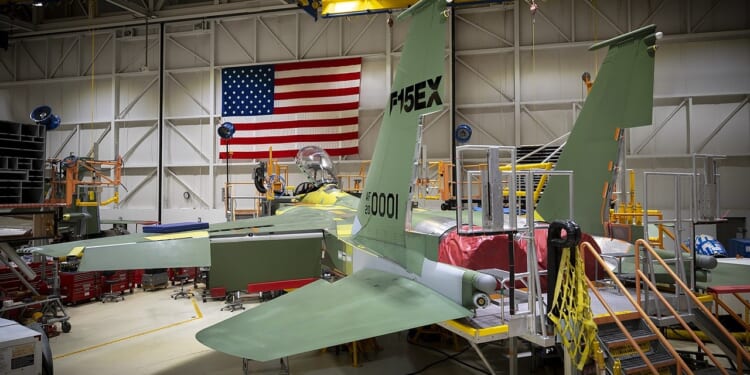Beyond the delays to the Portland Air National Guard Base, Oregon, the ongoing strike will impact deliveries of the multirole fourth-generation-plus aircraft to overseas locations.
On October 1, the federal government went into shutdown. For the first time in US history, there are concerns that the troops will not be paid; although it appears that troops will receive pay for the first two weeks of October from Pentagon discretionary funds, it is unclear if this funding will cover the second half of the month, if the shutdown continues.
Separately, the United States Air Force is also dealing with another headache: the ongoing labor Boeing strike at its facilities in St. Louis, Missouri, and St. Charles and Mascoutah, Illinois. The strike, involving more than 3,200 International Association of Machinists and Aerospace Workers (IAM) District 837 members, began in early August—and, like the shutdown, shows no sign of being resolved soon.
The strike could impact deliveries of military aircraft produced at those facilities, and potentially impact readiness far from the nation’s heartland.
The Strike Is Keeping America’s F-15EX Eagle IIs from Hatching
Last week, during the confirmation hearing for the Air Force chief of staff, nominee General Kenneth Wilsbach said in written testimony that deliveries of the F-15EX Eagle II have already been delayed.
“Lot 2 aircraft, initially expected to deliver this calendar year, are delayed due to the ongoing Boeing strikes, with 6 of 12 F-15EX delivered to date,” Wilsbach wrote. “These delays will impact F-15EX operations at Portland ANGB as well as delay initial OCONUS fielding of Lot 3 aircraft in CY 2026.”
However, the general did note that the Eagle II program has remained “within project cost, schedule, and performance criteria,” with all of the Lot 1 aircraft delivered to the Air Force.
The Air Force had initially called for 144 F-15EX, before slashing the order to 99 aircraft. However, Congressional lawmakers added funds that boosted the order to 129 Eagle IIs.
Beyond the delays to the Portland Air National Guard Base, Oregon, the ongoing strike will impact deliveries of the multirole fourth-generation-plus aircraft to overseas locations, notably the United States Air Force’s Kadena Air Base, Japan.
What Does the IAM Union Want?
The walkout has surpassed 70 days, exceeding the 2024 strike at the company’s commercial facilities in Washington and Oregon. The last strike lasted seven weeks and concluded after workers agreed to a new four-year contract that included a 38 percent wage increase, a $12,000 signing bonus, and other benefits.
The strikers in Missouri and Illinois are only about a tenth the size of the 33,000 machinists in the Pacific Northwest, but they are holding out for a similar contract. They rejected Boeing’s most recent proposal, which included a 24 percent pay increase over the next five years, along with a $4,000 bonus. IAM 837 had called for a 20 percent increase, a $10,000 bonus, and further raises for longtime employees of the aerospace giant.
Boeing has attributed its offer to the lower cost of living in the Midwest compared with the Pacific Northwest, where there are significantly higher housing prices.
Selling the workers of IAM 837 on that fact may be more challenging than just touting the cost of living.
“It’s going to be very hard to explain to these workers, thousands of them, that they have to settle for dramatically less than what their West Coast machinists did just a year ago,” Jake Rosenfeld, labor expert and chairman of the sociology department at Washington University, told NPR’s St. Louis on the Air on Monday.
Last year’s strike resulted in a slowdown in aircraft production at Boeing, and also contributed to the company’s net loss for fiscal year 2024 (FY24).
The US Navy’s F/A-18 Super Hornet Could Be Affected, Too
Beyond the delays to the F-15EX, the ongoing strike could impact deliveries of the F/A-18 Super Hornet. Boeing is now producing the final lot of Block III models for the United States Navy, which is expected to be completed by the end of the decade. The production lines were scheduled to be shuttered in 2027, and there has been speculation it would transition the work at the facilities in and around St. Louis to the F-47, the centerpiece sixth-generation aircraft of the US Air Force’s Next Generation Air Dominance (NGAD) program.
The US Navy has yet to award the contract for the F/A-XX, its sixth-generation manned fighter, and the competition is down to Boeing and Northrop Grumman.
It has been expected that the winning aerospace firm of the Navy contract would be named soon, but it is unclear if the ongoing strike is contributing to the delays.
About the Author: Peter Suciu
Peter Suciu has contributed over 3,200 published pieces to more than four dozen magazines and websites over a 30-year career in journalism. He regularly writes about military hardware, firearms history, cybersecurity, politics, and international affairs. Peter is also a contributing writer for Forbes and Clearance Jobs. He is based in Michigan. You can follow him on Twitter: @PeterSuciu. You can email the author: [email protected].
Image: Wikimedia Commons.


















